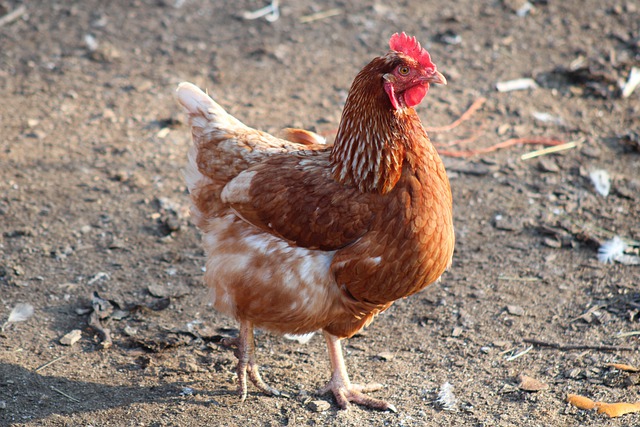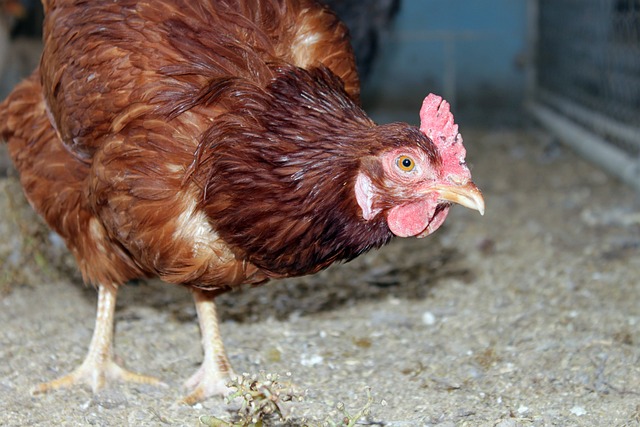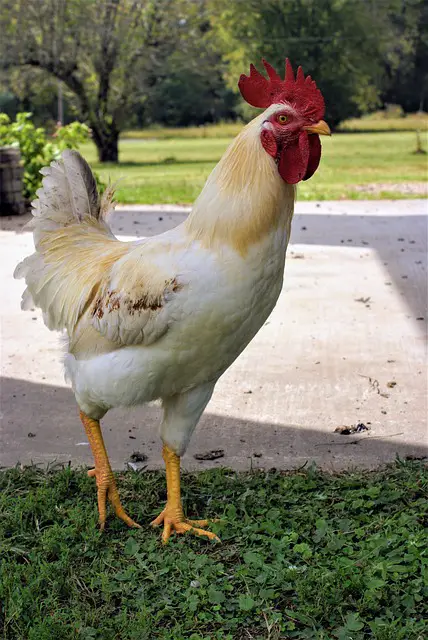Many may find it surprising, but in the world of poultry care, chicken poop is a vital marker of health and wellness. One of the most practical and efficient ways to monitor the wellbeing of your chickens is by observing their droppings.
A clear understanding of the appearance, consistency and frequency of healthy chicken poop can provide crucial insights into your flocks’ overall health, dietary adequacy, and even early warnings of potential illnesses. This article aims to equip you with much-needed information on characteristics of typical chicken poop, variances in poop caused by food changes, types of abnormal droppings and what they signify, as well as suggested responses to poop-related health issues in chickens.

Importance of Monitoring Chicken Poop
The Importance of Monitoring Chicken Poop
Monitoring the poop of chickens is a crucial aspect of raising healthy flocks. This task, while not glamorous, is a reliable way of assessing the well-being of these gallinaceous birds. The size, color, consistency and frequency of the droppings provide valuable insights into the bird’s health.
Chickens are often susceptible to various diseases like parasites, but the unique aspect is that many of these illnesses may manifest in their poop before physical symptoms become apparent. Increased or decreased droppings, changes in color or consistency, or the presence of blood or mucus can indicate different types of health challenges.
When the droppings of a chicken change, it often suggests a shift in their diet or possibly the early stages of disease. Hence, a regular check on their poop can be a effective preventive measure in maintaining the health of gold chicken breeds.
Do You Want Big Beautiful Eggs?
Then you must check this ORGANIC & NON-GMO feed. Our hens lay jumbo eggs now and they love this feed! You can check it right here on Amazon.
Investigating the Poop: Color, Consistency, and Components
A typical chicken dropping consists of a mix of brownish-green to white fecal material and a smaller, typically white or cream-colored uric acid deposit. Variations in color and consistency can be influenced by a number of factors including diet, hydration status, and overall physiological health.
A diet change can cause a significant color change in the poop. For example, a diet rich in green leafy vegetables might result in green poop, while corn in the diet might give a yellowish hue. If you notice any unexpected changes, it’s wise to review their recent food intake.
Another potential issue is whether or not your flock is ingesting enough chicken grit.
In addition to color, the consistency of the droppings provides valuable information on the hydration status of chickens. Loose stool may indicate over hydration, diarrheal disease or even stress, while an overly hard stool might reflect dehydration.
Perhaps the most telling sign when inspecting chicken poop is the presence of blood or mucus. Bloody stools can indicate a severe intestinal disorder such as coccidiosis, a parasitic disease. Mucus in the poop often suggests an infection in the chicken’s gastrointestinal tract.
Chicken Poop Observation: A Routine Task
Maintaining a flock of chickens requires regular inspection of their feces – a seemingly unpleasant yet necessary task. The frequency of these checks largely depends on the size of your flock and any suspected health risks. To maintain and promote good health in your flock, carrying out a brief daily examination and a thorough analysis on a weekly basis can be highly beneficial.
Should you detect any signs of possible health complications, it’s important to seek an expert consultation. A poultry expert or veterinarian can suggest further tests or recommend suitable treatments. Their advice may encompass a range of options, from administering antibiotics to making changes in diet or housing arrangements.
Ultimately, consistency in monitoring chicken poop is a proactive approach to ensuring the health and welfare of your flock. Regular checks can provide early warning signs of health issues, thus enabling timely intervention and treatment. This can speed up your flock’s recovery process, keeping them productive and contented.

Basic Characteristics of Healthy Chicken Poop
Recognizing Signs of Good Health in Chicken Poop
The appearance of healthy chicken feces may vary considerably, influenced by factors like diet, hydration, and overall health. Typically, feces from a healthy chicken should be firm with a white portion, known as urates. These white urates are largely comprised of uric acid, a sign of normal kidney function in the chicken.
Color is another distinguishing feature of healthy chicken feces. It can range from shades of green to brown. The brown color is usually due to digested feed, which shows a balanced diet. Conversely, bright green feces might suggest that the chicken has been consuming significant amounts of green vegetation. Although such color variations are normal, stool colors like red or black poops are usually concerning as they could suggest internal bleeding.
Another crucial factor is poop consistency. Healthy chickens generally produce firm and slightly moist feces. However, watery stool or feces containing undigested food may indicate that something is amiss. Loose or watery stool can be an indicator of stress, dietary imbalance, or serious illnesses like coccidiosis. Moreover, the presence of undigested food in the stool may indicate a rapid digestive transit time, another potential health issue.
Frequency and Variations in Chicken Poop
Frequency of defecation can also provide insightful information about your chicken’s health. A healthy and properly fed chicken generally defecates 8-12 times a day. However, this may vary as dietary changes or stress may cause a chicken to poop less or more than usual.
It is crucial to note that not all poop will look the same, even within the same day. Chickens usually have one large, red-brown, watery poop that contains more urates once or twice a day. This is known as a ‘cecal poop’ and it is completely normal. If these are the only types of droppings you’re seeing or if the chicken is having diarrhea, it could indicate a health problem.
The Implications of Diet on Chicken Droppings
Did you know that a chicken’s dietary habits have a significant influence on the characteristics of their poop? Have you recently changed the chicken feed for your flock? If a chicken consumes more leafy greens, it tends to produce greener droppings as opposed to one whose diet primarily consists of grains or commercially produced chicken feed. Similarly, chickens that feed on foods with higher water content, such as fruits like apples or zucchini, are likely to have more moist fecal matter.
It’s also noteworthy that keeping a keen eye on your chicken’s feces provides valuable insight into its health. So if you notice a significant change in your chicken’s poop characteristics without any notable changes in their diet, it may be wise to consult a vet for expert advice.

Types of Abnormal Chicken Poop and What They Mean
Identifying Normal Chicken Poop
To effectively monitor your chicken’s health through its droppings, you first have to familiarize yourself with what normal chicken feces looks like. Healthy chicken poop is usually a solid, firm mass wrapped in a layer of mucous. The color may vary, ranging from shades of brown to green, primarily influenced by the chicken’s diet. You may also find white patches in the poop, which is uric acid excreted from the chicken’s kidneys as part of its waste elimination process.
Watery or Unformed Stools
If the poop of your chicken appears watery or unformed, it may mean the chicken is under stress, has a dietary problem or its body is fighting an infection. It is normal for chickens to have slightly watery stools in hot weather or after consuming a large amount of green feed. However, if it continues for multiple days or becomes watery diarrhea, it may denote a more serious issue such as viral or bacterial infection, parasites, or malnutrition.
Yellow, Foamy, or Greasy-looking Poop
If the chicken’s poop appears yellow, foamy, or seems greasy, it’s an indication of coccidiosis, a parasitic disease that strikes the intestinal tract. This disease is more common in young or weakened chickens. Coccidiosis causes significant damage to the intestinal wall and can lead to severe dehydration, anemia, and often death if left untreated.
Bright Green Poop
Bright green chicken poop can be a sign of two things. One, the chicken is eating a large amount of green material, such as grass or vegetables. Two, it could be a symptom of a chicken that is starving, known as starvation diarrhea. In the latter case, the green color comes from bile pigment that passes through the chicken’s digestive track into the droppings.
Blood in Poop
Seeing blood in a chicken’s poop is cause for immediate concern. This symptom often indicates coccidiosis, especially in newly hatched chicks. It can also be a sign of necrotic enteritis or other bowel diseases, which can be quite lethal. In some cases, blood might also signal the presence of intestinal worms.
White Poop
While a healthy chicken’s poop often contains white patches (uric acid), if the entire dropping is white, it might be indicative of kidney issues or a very high uric acid level, often related to the excessive protein in feed.
Black, Tarry Poop
If your chicken’s poop appears black and tarry, it could indicate that there’s bleeding in the upper parts of your chicken’s digestive track. The black color is a result of the blood being digested before it is excreted.
To ensure the health of your chickens, it’s important to keep a close eye on the color, texture, and contents of their excretions. Abnormalities in chicken poop can often be a sign of underlying health concerns, making regular check-ins critical. Recognizing what is normal, and what indicates a potential problem, is vital for dealing with issues swiftly and efficiently to maintain the well-being and happiness of your chickens.
However, it is crucial to seek advice from a professional veterinary practitioner should any changes or concerns be noticed. This guide is simply a tool for identifying potential problems and is not meant to serve as a substitute for professional advice.

How to Handle Poop-Related Health Concerns in Chickens
Deciphering Chicken Poop: Indicators of Health
Before you can effectively recognize abnormal poop signs in chickens, it is essential to know what normal, healthy chicken poop looks like. The natural color range of healthy chicken droppings encompasses shades of yellow, green, brown, and even white. A white ‘cap’ on droppings usually signifies a healthy urinary system and is generally a positive sign. In terms of texture, droppings should be firm, but not overly hard, indicating proper digestion.
Addressing Dietary Adjustments
One of the most common approaches to address concerning chicken poop conditions revolves around dietary adjustments. If chickens produce watery or overly soft poop, it may signify an overly rich or unbalanced diet. Incorporating more grains or fibrous foods can aid in regulating bowel movements and result in healthier-looking droppings. Stringy poop can signify worms, requiring a chicken-safe de-wormer, a supplement that can also be integrated into the feed.
Isolation and Care
When encountering a chicken with consistent abnormal poop, it might be necessary to isolate the bird temporarily. This approach prevents potentially contagious diseases from spreading to the rest of the flock. Once isolated, note any additional symptoms such as changes in behavior, lethargy, or loss of feathers. This can assist in understanding the underlying health concern.
Seeking Professional Assistance
It is essential to seek professional help when your chicken’s condition doesn’t improve with initial measures. Veterinarians who specialize in avian health are equipped to diagnose more serious conditions that can cause aberrations in chicken poop. They can prescribe appropriate medication or suggest effective treatment plans in response to diseases such as coccidiosis or other parasitic infections.
The Use of Home Remedies
Home remedies can be used to address minor health conditions that result in abnormal chicken poop. Garlic cloves in the drinking water can act as a mild, natural antibiotic, while apple cider vinegar can help with digestion issues. However, always consult with a professional before applying any home remedies to the diet or living environment of your chickens.
The Importance of Veterinary Advice
While home remedies can be useful for minor health concerns, overreliance on such treatments and overlooking the importance of veterinary advice can lead to more serious health problems. A veterinarian can perform appropriate health checks, diagnose severe health conditions, and prescribe suitable medication. As such, reaching out to a vet when a problem first arises, or regularly for check-ups, can nip health problems in the bud before they worsen.
In sum, understanding, monitoring, and appropriately responding to abnormal chicken poop can help maintain a healthy flock. Whether through diet alterations, isolation, home remedies, or seeking professional assistance, these steps can go a long way in addressing poop-related health concerns in chickens. Always remember that veterinary advice serves as the most reliable source of information and treatment when dealing with chicken health.
Chicken Poop Questions
- What does normal chicken poop look like? Normal chicken poop typically varies in color from brown to green, depending on their diet and health. It has a somewhat liquid consistency and may contain a white or lighter-colored portion, which is the urate, a concentrated form of waste.
- Why does chicken poop change color? Chicken poop can change color due to various factors. Greenish poop might indicate that the chicken has been eating a lot of grass or leafy greens. Changes in diet, stress, illness, or even consuming certain foods can lead to alterations in poop color.
- Is there such a thing as abnormal chicken poop? Yes, abnormal chicken poop can signal potential health issues. Watery or overly runny poop, blood in the poop, or significant changes in color (especially if accompanied by other symptoms like lethargy) might be a cause for concern. Monitoring poop consistency and color can help identify health problems early.
- What can I do to keep the coop clean and manage chicken poop? Maintaining a clean coop is crucial for the health of your chickens. Regularly cleaning out droppings and replacing bedding helps prevent the buildup of harmful bacteria. You can also use materials like straw or wood shavings as bedding to absorb moisture and manage odors.
- Can chicken poop be used as fertilizer? Yes, chicken poop is a valuable source of nitrogen-rich fertilizer. However, it’s important to compost it properly before using it on plants, as fresh chicken manure can be too strong and might burn plants. Composting allows the poop to break down and become a nutrient-rich amendment for gardens and lawns.
meaning behind color of chicken poop
- What does it mean if my chicken’s poop is green? Green chicken poop can result from a diet rich in leafy greens, like grass or certain vegetables. It’s usually not a cause for concern unless accompanied by other abnormal symptoms.
- Is it normal for chicken poop to be black? Black chicken poop can be a sign of digested blood, usually from eating dark-colored foods or because of certain dietary additives. However, if black poop persists or is accompanied by other issues, consulting a veterinarian is recommended.
- Why is my chicken’s poop white or chalky? White or chalky portions in chicken poop are urates, a concentrated form of waste. These are normal and often found alongside the brown or green feces. They’re usually a healthy sign, but if the entire poop is consistently white, it could indicate a problem.
- What does it mean if my chicken’s poop is runny or watery? Runny or watery poop, often called “diarrhea,” can be a sign of various health issues such as infections, parasites, stress, or dietary problems. If it persists for more than a day or is accompanied by lethargy, it’s essential to investigate further.
- Why is my chicken’s poop red or bloody? Red or bloody chicken poop can be alarming and might indicate internal bleeding, injury, or diseases affecting the digestive tract. It’s crucial to identify the source of blood and consult a veterinarian immediately to ensure your chicken’s health.
Final Thoughts
This guide has aimed to provide a comprehensive analysis of chicken poop, offering an insightful take on why your flock’s droppings should be one aspect of their health you must not overlook. Please consult a licensed veterinarian if you have any concerns about your chickens. By knowing what to expect from a healthy chicken in terms of poop consistency, color, and frequency, you arm yourself with knowledge that will aid in early detection of potential health issues. More importantly, this discussion has outlined directions on handling various poop-related health conditions, reminding us that professional advice is paramount, no matter how equipped one is with chicken care information. Remember, successfully managing your flock’s health and wellness begins with something as simple as understanding their poop. Happy chicken farming!


